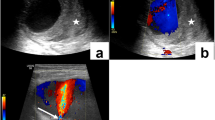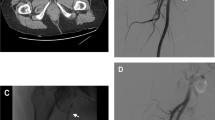Abstract
Pseudoaneurysms are vascular abnormalities caused by a damaging force on an arterial wall, resulting in a persistent extravasation of blood into the surrounding tissue, which can be the result of infection, inflammation, trauma or any iatrogenic procedure. The incidence of extremity artery pseudoaneurysms is rising because of increased number of endovascular procedures. As a number of complications are associated with these false aneurysms, it is important to know the treatment modalities available. Ultrasound is the most common method of diagnosing extremity pseudoaneurysm because of their superficial location. Computed tomographic angiography is the next investigation of choice as it has three-dimensional capability and can help evaluate the vascular bed. Digital subtraction angiography is rarely used for diagnosis alone, and is used only when a therapeutic procedure is planned. Treatment of these pseudoaneurysms has shifted from open surgical procedures to minimally invasive treatment in recent years. The different techniques for tackling these lesions include ultrasound-guided compression, percutaneous thrombin or glue embolisation and endovascular coil or stent graft placement. In this pictorial essay, we review the different treatment modalities so that an interventional radiologist is aware of all the treatments he can offer when confronted with these lesions.










Similar content being viewed by others

Data availability
Not applicable
Code availability
Not applicable
References
Raherinantenaina F, Rajaonanahary TMA, RakotoRatsimba HN (2016) Management of traumatic arterial pseudoaneurysms as a result of limb trauma. Formos J Surg 49(3):89–100
Sueyoshi E, Sakamoto I, Nakashima K, Minami K, Hayashi K (2005) Visceral and peripheral arterial pseudoaneurysms. AJR Am J Roentgenol 185(3):741–749
Saad NEA, Saad WEA, Davies MG, Waldman DL, Fultz PJ, Rubens DJ (2005) Pseudoaneurysms and the role of minimally invasive techniques in their management. Radiogr Rev Publ Radiol Soc North Am Inc 25(Suppl 1):S173-89
Morgan R, Belli A-M (2003) Current treatment methods for postcatheterization pseudoaneurysms. J Vasc Interv Radiol 14(6):697–710
Raherinantenaina F, Rakoto-Ratsimba HN, Rajaonanahary TMA (2016) Management of extremity arterial pseudoaneurysms associated with osteochondromas. Vascular 24(6):628–637
Sarioglu O, Capar AE, Belet U (2019) Interventional treatment options in pseudoaneurysms: different techniques in different localizations. Polish J Radiol 84:e319–e327
Katzenschlager R, Ugurluoglu A, Ahmadi A et al (1995) Incidence of pseudoaneurysm after diagnostic and therapeutic angiography. Radiology 195(2):463–466
Coughlin BF, Paushter DM (1988) Peripheral pseudoaneurysms: evaluation with duplex US. Radiology 168(2):339–342
Soto JA, Múnera F, Morales C et al (2001) Focal arterial injuries of the proximal extremities: helical CT arteriography as the initial method of diagnosis. Radiology 218(1):188–194
O’Sullivan GJ, Ray SA, Lewis JS et al (1999) A review of alternative approaches in the management of iatrogenic femoral pseudoaneurysms. Ann R Coll Surg Engl 81(4):226–234
Sharma NK, Chin KF, Modgill VK (2001) Pseudoaneurysms of the femoral artery: recommendation for a method of repair. J R Coll Surg Edinb 46(4):195–197
Gorsi U, Agarwal V, Yaser M, Kalra N, Chaluvashetty S, Kang M, Lal A, Sandhu MS (2020) Utility of percutaneous thrombin injection for treating visceral pseudoaneurysms. Minim Invasive Ther Allied Technol 31:1–5. https://doi.org/10.1080/13645706.2020.1720251
Sizemore G, Ayubi F, Clark B, Kellicut D (2018) Ultrasound-guided percutaneous thrombin injection following iatrogenic femoral artery pseudoaneurysm: patient selection and perspectives. J Vasc Diagn Interv 6:1–5
Gorsi U, Chaluvashetty S, Kalra N, Kang M, Bhatia V, Lal A, Singhal M, Vyas S, Ahuja CK, Kumar A, Gupta V, Khandelwal N (2020) Percutaneous glue embolization as a primary treatment for visceral pseudoaneurysms. Minim Invasive Ther Allied Technol 29(3):170–176. https://doi.org/10.1080/13645706.2019.1606019
Lal A, Bansal A, Chaluvashetty SB, Sandhu MS, Gorsi U (2021) Percutaneous transthoracic embolisation for massive haemoptysis secondary to peripheral pulmonary artery pseudoaneurysms. Eur Radiol 31(4):2183–2190. https://doi.org/10.1007/s00330-020-07348-w
Author information
Authors and Affiliations
Corresponding author
Ethics declarations
Conflict of interest
The authors declare that they have no conflict of interest.
Additional information
Publisher's note
Springer Nature remains neutral with regard to jurisdictional claims in published maps and institutional affiliations.
Rights and permissions
About this article
Cite this article
Bansal, A., Gorsi, U., Farook, S. et al. Interventional radiology management of extremity pseudoaneurysms: a pictorial essay. Emerg Radiol 28, 1029–1039 (2021). https://doi.org/10.1007/s10140-021-01939-w
Received:
Accepted:
Published:
Issue Date:
DOI: https://doi.org/10.1007/s10140-021-01939-w



